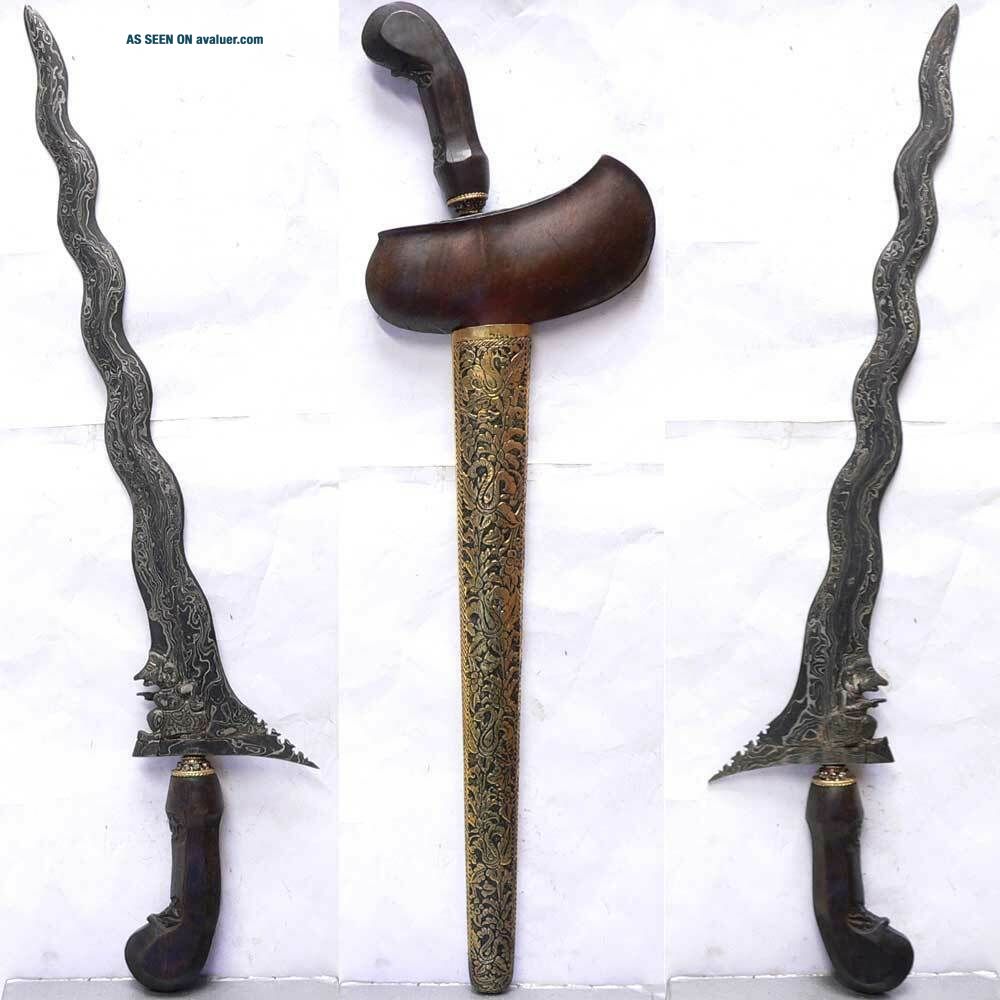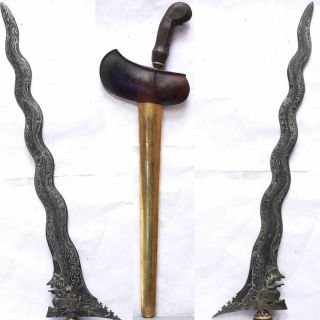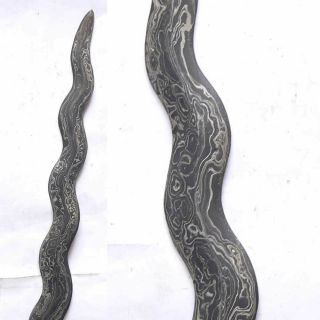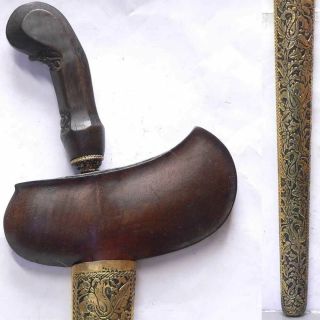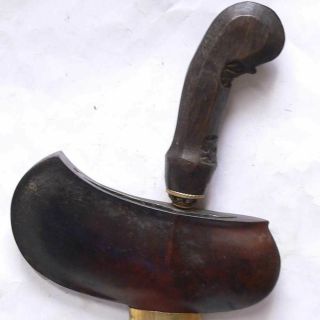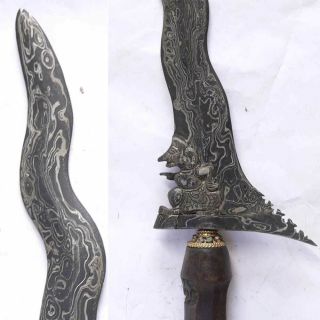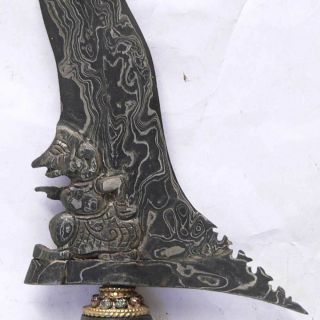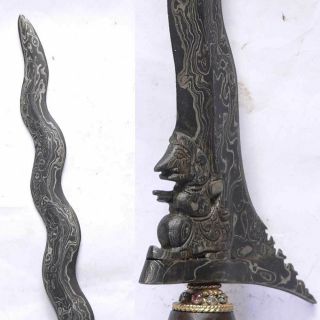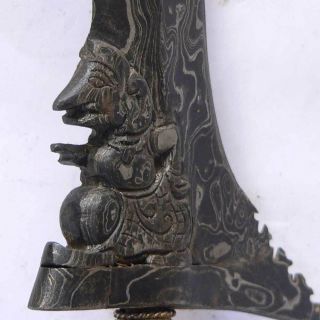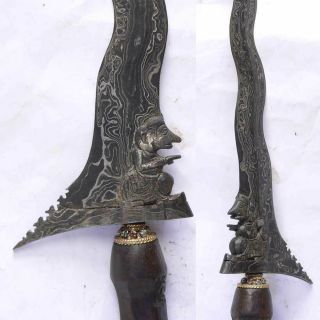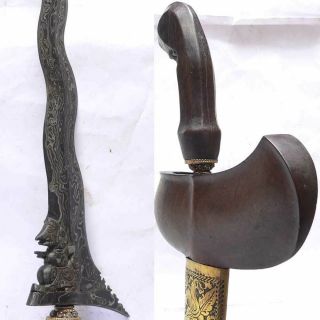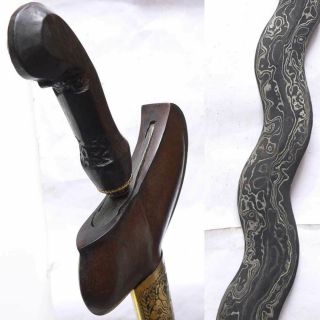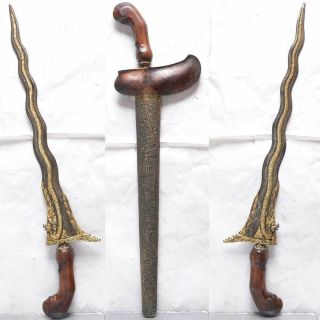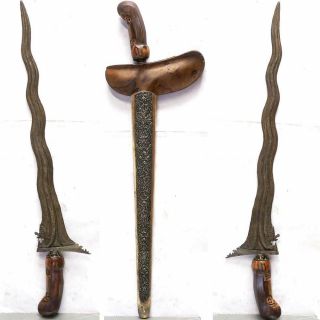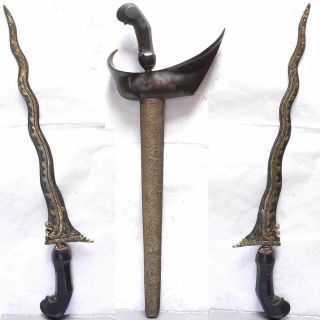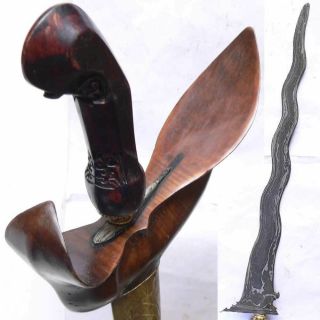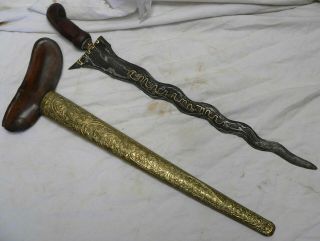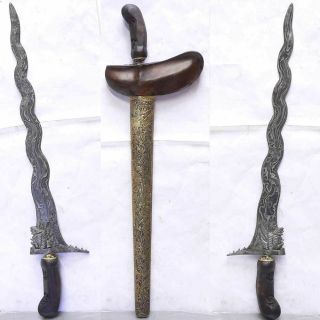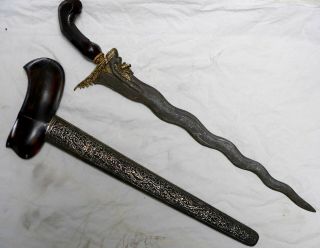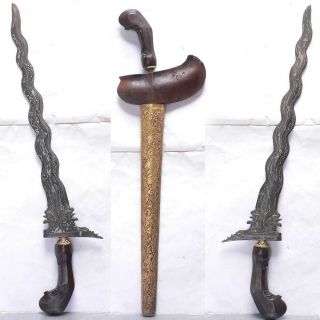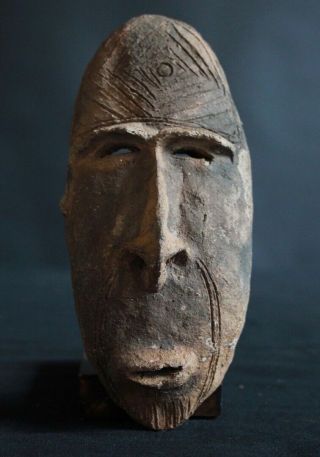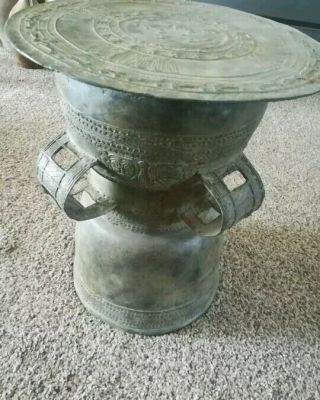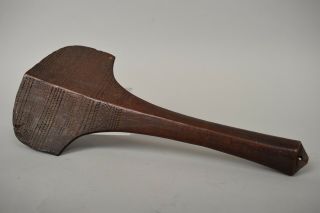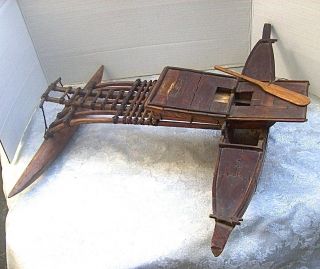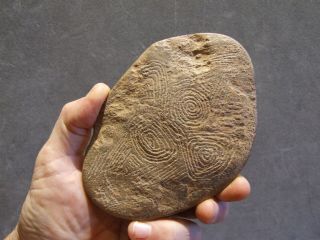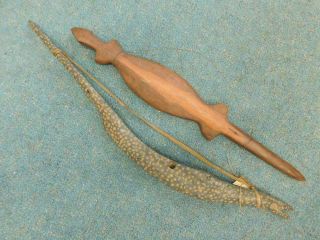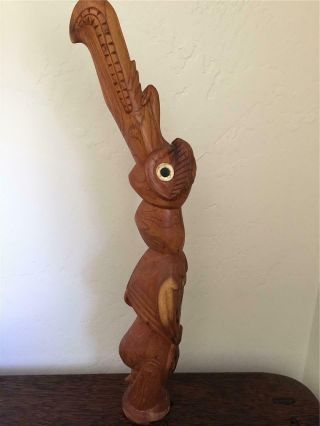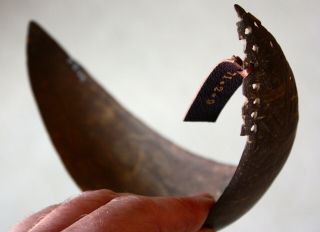11 Lok SEMAR KRIS Keris Solo Surakarta Wayang Puppet Sword Dagger Java Indonesia
Item History & Price
| Reference Number: Avaluer:32385 | Original/Reproduction: Original |
| Country of Origin: Indonesia | Category: Antiques Ethnographic |
| Asian Culture: Indonesia |
Indonesian keris (kris) with Semar figure in the blade
I'm selling a collection of old Indonesia goods, mainly weapons and statues. This one was labelled "11 lok Semar kris uit Surakarta". For Semar I found: ...Semar is a character in Javanese mythology who frequently appears in wayang shadow plays. He is one of the punokawan (clowns), but is in fact divine and very wise. He is the dhanyang (guardian spirit) of Java, [...1] and is regarded by some as the most sacred figure of the wayang set.[2] He is said to be the god Sang Hyang Ismaya in human form.[3][4]The name Semar is said to derive from the Javanese word samar ("dim, obscure, mysterious")…..As Semar is one of the few characters in wayang stories not from Indian mythology, his origin is obscure. One hypothesis is that he and his sons are old indigenous deities who became cursed and demoted to servants with the importation of the kshatriya heroes of the Indian epics.[8][9] Semar also resembles the vidusaka clown figure of Indian Sanskrit drama.[10]The first known appearance of Semar is during the Majapahit era. In 1358 in relief of Sudamala in Candi TIgamangi, and in Candi Sukuh dated 1439. The relief was copied from a wayang story from the period, where Semar was first known to be appeared…...n one version of the Babad Tanah Jawi (the Javanese creation myth), Semar cultivated a small rice field near Mount Merbabu for ten thousand years before there were any men. His descendents, the spirits of the island, came into conflict with people as they cleared fields and populated the island. A powerful priest, unable to deviate from his king's orders to continue cultivating the island, provided Semar with a role that will allow his children and grandchildren to stay. Semar's role was to be a spiritual advisor and magical supporter of the royalty, and those of his descendents who also protect the humans of Java can remain there.[1]One genealogy of Semar is that he is the eldest descendent of God, and elder brother to Batara Guru, king of the other gods; however, Semar became a man.[12] Another genealogy says that he is the son of Adam and Eve. His brother Nabi ("prophet") Sis gave birth to various prophets, such as Jesus and Muhammad, from whom the various Western peoples are descended, while Semar ("Sayang Sis") gave birth to the Hindus and the Javanese.[12] In either case Semar, in his awkward, ugly human form, represents at the same time god and clown, the most spiritually refined and outwardly rough….
...Semar also appears on some ceremonial weapons, the pusaka of some important families. In this role he represents an ancestral figure.[17]There is a low rectangular candi on the Dieng Plateau known as Candi Semar, perhaps originally a treasury, [18] but it is generally assumed by scholars that its name was given to the temple centuries after its erection.[19] In Bali, the counterpart of Semar is Twalen...
For 11 lok I found:..Luk is a number corresponding with the number of such waves, always odd from 3 up to 29 and above. Luk is one attribute of dapur. Luk 3: mametri/pepeling = horizontal dedication (jangkung)Luk 11 : for wealth, nobility/mangku kamukten (sabuk inten)
For Surakarta I found:...Surakarta (Hanacaraka : ꦯꦸꦫꦏꦂꦠ, often called Solo and less commonly Sala), is a city in Central Java, Indonesia of more than 520, 061 people (2009)[1] with a population density of 11, 811.5 people/km2. The 44 km2 city[2] adjoins Karanganyar Regency and Boyolali Regency to the north, Karanganyar Regency and Sukoharjo Regency to the east and west, and Sukoharjo Regency to the south.[3] On the eastern side of Solo lies Bengawan Solo River. The city is the seat of Surakarta Sunanate kraton (palace/court). Together with Yogyakarta, Surakarta is the heir of the Mataram Kingdom that was split into two kingdoms in 1755.Surakarta is the birthplace of the current president of Indonesia, Joko Widodo. He led as mayor of Surakarta from 2005 to 2012.
Foundation of the dynastyA series of wars and clashes between the Adipati (dukes) followed the death of the last Sultan of Demak Bintoro, [citation needed] the first Islamic kingdom in Java. One of these was Jaka Tingkir, son-in-law of the late sultan. After defeating the last opponent duke of Jipang-Panola, Jaka Tingkir, also known as Sultan Hadiwijaya, he claimed the throne and moved the capital to the city of Pajang, located about 8 miles from present-day Surakarta. His adopted son, Sutawijaya, formed a conspiracy and killed him with the help of an assassin. Then he ascended the throne and once again moved the capital to Mataram in the present-day province of Yogyakarta, and a new dynasty was founded.Pakubuwono II Tower and portal of Kraton SurakartaUp until 1744, Solo was little more than a quiet backwater village, 10 km east of Kartasura, the contemporary capital of the Mataram kingdom. But in that year the Mataram susuhunan (king), Pakubuwono II, backed the Chinese against the Dutch, and the court at Kartasura was sacked as a result. Pakubuwono II searched for a more auspicious spot to rebuild his capital, and in 1745 the entire court was dismantled and transported in a great procession to Surakarta, on the banks of the Kali (River) Solo. February 18, 1745 is regarded as the official birthday of the city. It was said that the place he chose to be the new palace was situated on a small lake. The "babad" or official record of court historians still mentions that the lake was drained by the favor of the mythical queen of the southern sea, Nyi Roro Kidul. The Wayang Orang performed at the Gedung Wayang Orang, SriwedariHowever, the decline continued, and in 1757, after the kingdom of Mataram was divided into the Surakarta Sultanate (northern court) and the Yogyakarta Sultanate (southern court), another rival royal house of Mangkunegoro was established by Raden Mas Said, also known as Pangeran Samber Nyowo (The Slayer Prince), right in the centre of Solo. It marked the success of the Dutch policy of divide et impera (divide and conquer) in the East Indies. The Mataram held considerable power in Java, yet it submitted to the Dutch. Thereafter, Solo's royal houses quit fighting and instead threw their energies into the arts, developing a highly sophisticated and graceful court culture. The gamelan pavilions became the new theaters of war, with each city competing to produce the more refined court culture. Wayang Kulit and Wayang Wong are some theatrical arts still performed today.The Palace contains a notable museum, which used to house a female chastity belt until it was stolen by thieves.Pakubuwono XPerhaps the most significant ruler of the 20th century was Pakubuwono X. His relationship with the Dutch, his large family, and his popularity contributed to perhaps the largest funeral procession that ever occurred in Solo. He had spent a large amount of money on the Royal Graveyard at Imogiri, both the main sections of the graveyard and the new section that he was buried in. In the era just prior to independence Surakarta had European, Chinese, and Arab quarters.Struggle for IndependenceAfter hearing the proclamation of Indonesian Independence, both Mangkunegara VII and Pakubuwono XII declared Surakarta a part of the Republic of Indonesia (RI). Because of this support, President Soekarno declared Surakarta the Daerah Istimewa Surakarta (DIS)/"Surakarta Special Region".In October 1945, an anti-"swapraja" (anti-feudalism/anti-monarchy) movement was established in Surakarta. One of the leaders of this movement was Tan Malaka, a member of the Indonesian Communist Party. This organization wanted to abolish all feudal kingdoms in Surakarta and the Surakarta special region (DIS) and replace all regents in Surakarta. The key issue was whether the end of Dutch rule should bring a total change in the government, or whether the ancient and historic institutions, giving the people a link to pre-colonial times, should be retained.On October 17, 1945, KRMH Sosrodiningrat, the vizier of Kasunanan kingdom, was kidnapped and murdered by communists. The new vizier, KRMT Yudonagoro, and 9 other officials from Kepatihan were also kidnapped and murdered by the same movement in March 1946.In 1946, the capital of the Republic of Indonesia (RI) was moved to the nearby city of Yogyakarta.On June 16, 1946, the DIS was abolished and replaced with the regency (kabupaten) of Surakarta. This event is commemorated as the birthday of the city of Surakarta. This only has administrative and not civic significance.On June 26, 1946, Prime Minister of Indonesia Sutan Syahrir was kidnapped by a rebel movement led by Major General Soedarsono, the commander of the 3rd division. President Soekarno (more often called Sukarno) was angry at this kidnapping and on July 1, 1946, 14 civilian leaders of this movement, including Tan Malaka, were arrested by Indonesian police.On July 2, 1946, the rebel leaders were freed from Wirogunan prison by rebel troops, led by Maj. Gen. Soedarsono. President Soekarno asked the local military commander in Surakarta, Lieutenant Colonel Soeharto (who later became President Soeharto [often spelled Suharto]) to arrest Major General Soedarsono and the rebel group. Lt. Col. Soeharto refused to follow this command unless it was given directly by the Military Chief of Staff, General Soedirman. President Soekarno was angry at this rejection of his authority to give direct commands to all levels of the military, and called Lt. Col. Soeharto a stubborn ("koppig") officer.Lt. Col. Soeharto pretended that he supported the rebellion and persuaded Maj. Gen. Soedarsono and his group to stay at his headquarters at Wiyoro, Surakarta for their own safety. Later that night he persuaded Maj. Gen. Soedarsono to meet President Soekarno at his palace the next morning. Lt. Col. Soeharto secretly informed the presidential guard troops about Maj. Gen. Soedarsono's plan on the next morning.A statue of Slamet Riyadi in SurakartaOn July 3, 1946, Maj. Gen. Soedarsono and his group were arrested by the presidential guard near the palace. Prime Minister Syahrir was released unharmed. Several months later, Maj. Gen. Soedarsono and his group were pardoned and released from prison.Later this rebellion was called the "failed July 3, 1946 coup". This event is mentioned in President Soeharto's autobiography published in 1988.From 1945 to 1948, the Dutch re-occupied various regions in Java. The remaining areas of the Republic of Indonesia were in Yogyakarta, Surakarta, and surrounding areas.In December 1948, the Dutch attacked and occupied the cities of Yogyakarta and Surakarta. The Indonesian army led by General Soedirman started a guerrilla war from surrounding areas. The Dutch said that the Republic was destroyed and no longer existed. To disprove this claim, the Indonesian army conducted large-scale raids into the cities of Jogyakarta and Surakarta, called Serangan Oemoem. The Indonesian troops managed to beat the Dutch troops and occupy the city for several hours. The leader of the raid to Yogyakarta was Lt. Col. Soeharto. The leader of a similar raid on Surakarta on August 7, 1949 was Lt. Col. Slamet Riyadi. To commemorate this event, the main street of the city of Surakarta was renamed "Brigadier General Slamet Riyadi Street".
This kris / dagger has a very nice wood handle and wooden scabbard with decorated oversheath. The Blade has waves/curved and also the upper cross part of the blade (gonjo) is waving.The kris is in total 52cm long, the blade only is 39cm.
00025



